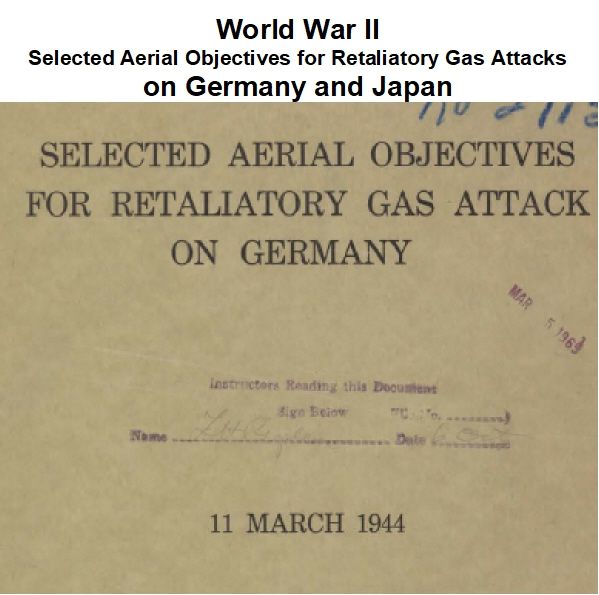
World War II Selected Aerial Objectives for Retaliatory Gas Attacks on Germany and Japan
$1.90
Description
Chemical Warfare Service: Unused WWII Gas Attack Plans
1944
- March 11: The Office of the Assistant Chief of Air Staff, Intelligence, creates a 123-page report titled “World War II Selected Aerial Objectives for Retaliatory Gas Attack on Germany.” This study analyzes the number and types of targets in Germany suitable for USAAF retaliatory gas attacks, subject to specific limitations. The conclusions are seen as a reasonable basis for outlining such a program, pending further experience from the USAAF and Chemical Warfare Service.
- December: The Chief of the Chemical Warfare Service, The Air Chemical Officer, prepares a 121-page report titled “Selected Aerial Objectives for Retaliatory Gas Attack on Formosa.” These target folders are intended to furnish field chemical officers with general chemical warfare data for permanent key and priority tactical gas targets in Formosa. The material is based on currently available, though sometimes fragmentary, intelligence and is subject to modification.
1944 (Ongoing)
- The United States policy during World War II permits the use of gas only in retaliation for enemy gas attacks.
- The Chemical Warfare Service (CWS) operates under the unique circumstance of preparing for a type of warfare (gas warfare) that ultimately does not materialize. Despite this, the CWS serves as an “insurance” against enemy gas use and strives to be useful in a conventional, gasless war.
1997
- Stephen L. McFarland delivers a lecture titled “Battles Not Fought: The Creation of an Independent Air Forces” at the United States Air Force Academy.
Undated (Publication of Historical Works)
- The U.S. Army’s Center for Military History publishes “United States Army in World War II The Technical Services The Chemical Warfare Service: Chemicals In Combat.” This 716-page history is the third of three volumes on CWS activities during World War II, focusing on administration, logistics, and combat overseas.
Cast of Characters
- Stephen L. McFarland: A professor of history at Auburn University (Ala.), and formerly a visiting professor at Air War College, Maxwell AFB, Alabama. He gave a lecture in 1997 titled “Battles Not Fought: The Creation of an Independent Air Forces.”
- Office of the Assistant Chief of Air Staff, Intelligence (USAAF): A department within the United States Army Air Force responsible for intelligence gathering and analysis, particularly as it relates to air operations. They created the detailed 1944 report on retaliatory gas attack objectives in Germany.
- Chief of the Chemical Warfare Service, The Air Chemical Officer: A high-ranking official within the Chemical Warfare Service, responsible for chemical warfare planning and intelligence. This office prepared the 1944 report on retaliatory gas attack objectives for Formosa.
- United States Army Air Force (USAAF): The aerial warfare service component of the United United States Army during and immediately after World War II. They were the intended executors of any retaliatory gas attacks.
- Chemical Warfare Service (CWS): A technical service branch of the United States Army during World War II, responsible for developing, procuring, and deploying chemical weapons and defenses. Their role was unique in preparing for gas warfare that was never employed by the enemy, while also contributing to conventional combat efforts.
World War II Selected Aerial Objectives for Retaliatory Gas Attacks on Germany and Japan
This collection has a total of 969 pages.
World War II Selected Aerial Objectives for Retaliatory Gas Attack on Germany, 11 March 1944
A 123-page report created by the Office of the Assistant Chief of Air Staff, Intelligence.
Abstract: This study is an analysis of the number and types of targets in Germany which might be attacked by the United States Army Air Force (USAAF) in retaliation for the use of gas by Germany. As noted in the text, this retaliation program has important limitations on its scope. Within the framework of these limitations, both the air effort which the USAAF will be capable of exerting and the German cities which offer suitable targets have been studied. The conclusions which have been reached are subject to modification in the light of further experience by both the USAAF and the Chemical Warfare Service, but it is believed that they provide a reasonable basis for outlining a retaliatory gas attack program.
Selected Aerial Objectives for Retaliatory Gas Attack on Formosa December 1944 (1944)
A 121-page report prepared by the Chief of the Chemical Warfare Service, The Air Chemical Officer
Abstract: These target folders were prepared with the view to furnishing chemical officers in the field with suitable general chemical warfare data which can be incorporated in objective folders of permanent key and priority tactical gas targets in Formosa. The material contained herein is based on currently available intelligence which in some cases is o f a fragmentary nature. Such material is subject to modification as a result of changing conditions and as more recent and complete intelligence becomes available.
Additional material includes:
Battles Not Fought: The Creation of an Independent Air Forces (1997)
A lecture given at the United States Air Force Academy by Stephen L. McFarland professor of history at Auburn University (Ala.) and formerly a visiting professor at Air War College, Maxwell AFB, Alabama.
United States Army in World War II The Technical Services The Chemical Warfare Service: Chemicals In Combat
A 716-page history by the U.S. Army’s Center for Military History.
Abstract: Chemicals in Combat is the last of three volumes concerned with the activities of the Chemical Warfare Service in World War II. It is devoted to the overseas story—administration, logistics, and combat. In World War II the CWS faced a unique situation, in that it found itself in the unenviable position of preparing for an unconventional kind of warfare that never came to pass. Yet, even as it served as insurance in the event of the introduction of gas by the enemy (United States policy permitted the use of gas only in retaliation), it also had to be useful in a gasless war.
Related products
-
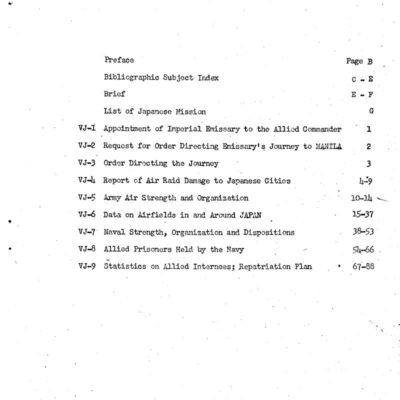
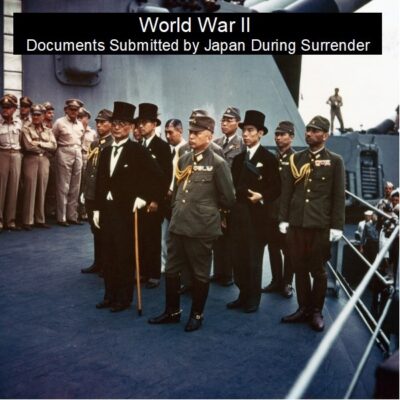
Japan’s Surrender Documents from World War II
$1.99 Add to Cart -
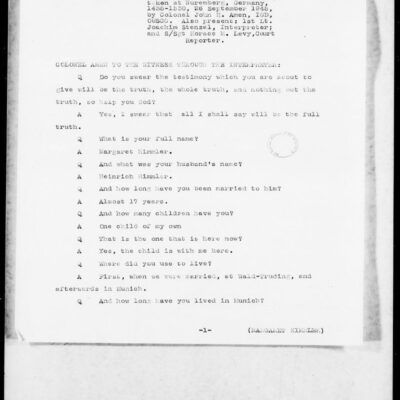
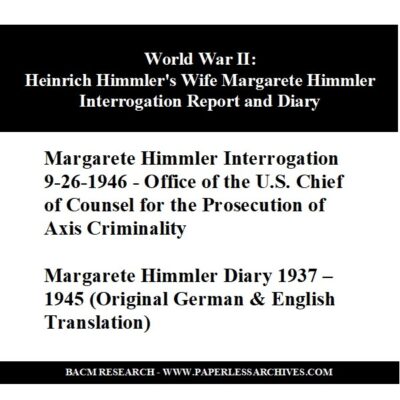
World War II: Interrogation Report and Diary of Margarete Himmler, Wife of Heinrich Himmler
$3.94 Add to Cart -
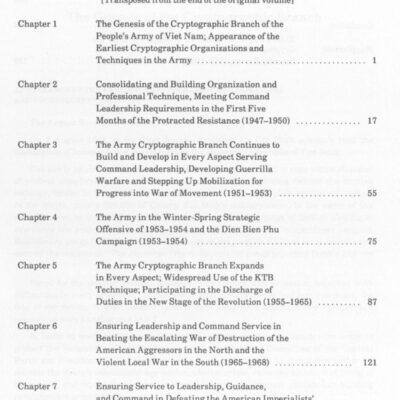
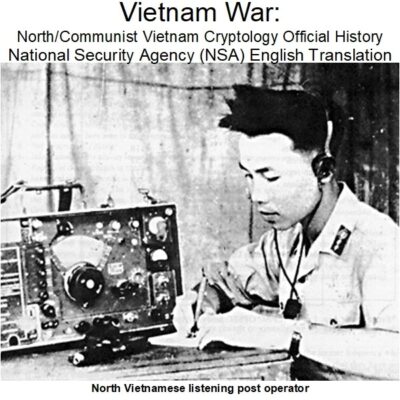
Vietnam War: Cryptology in North Vietnam – NSA Official History
$4.90 Add to Cart -
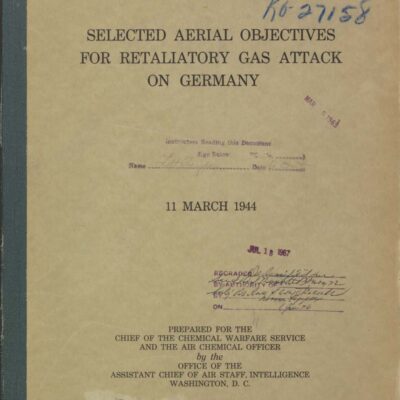
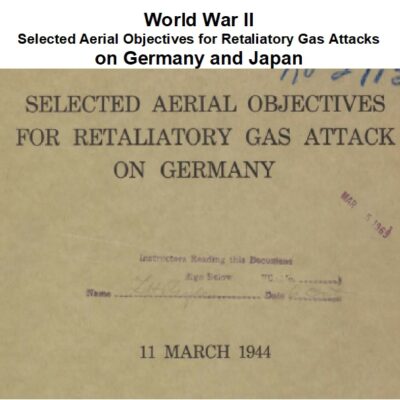
World War II: Targeted Aerial Objectives for Retaliatory Gas Attacks on Germany and Japan
$3.94 Add to Cart